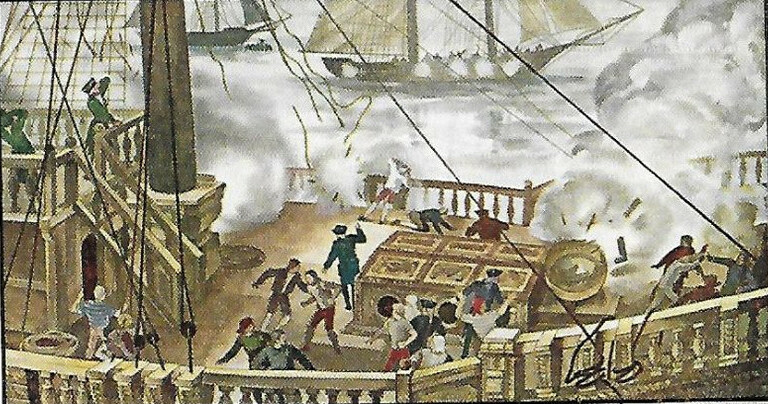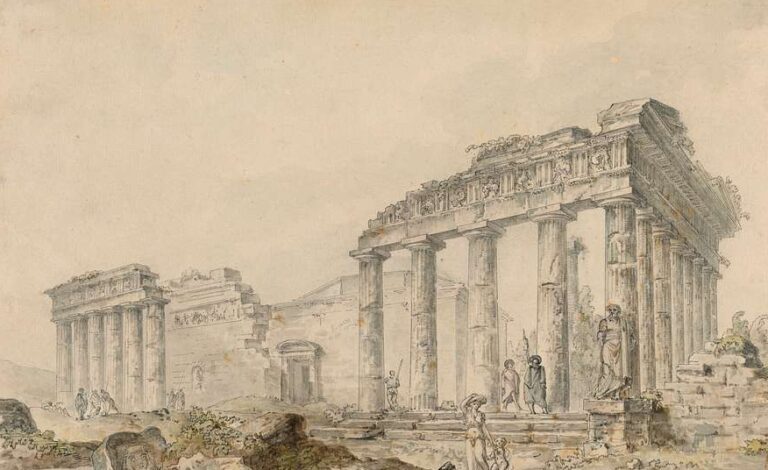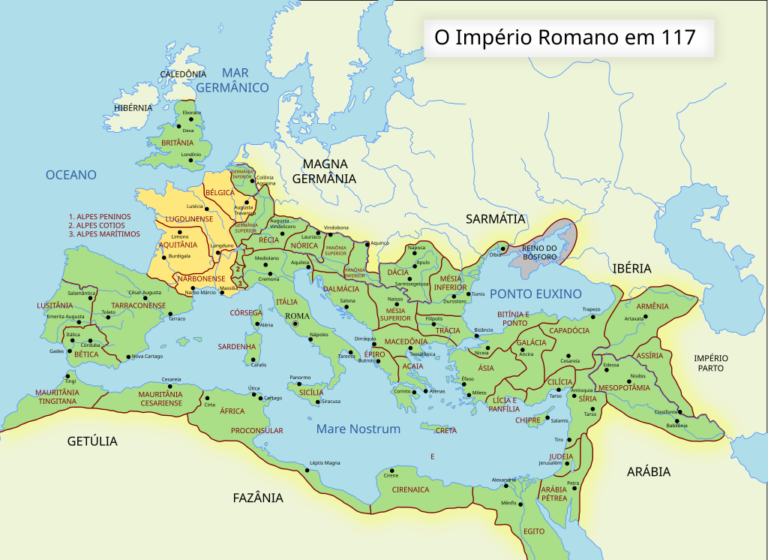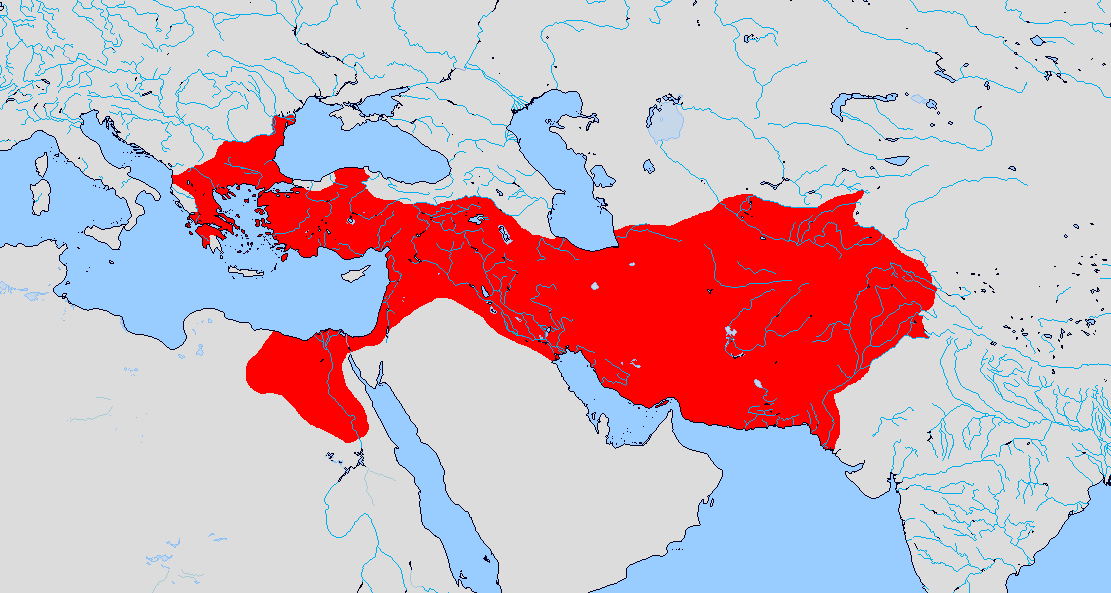
Throughout history, empires have risen and fallen, leaving an indelible mark on the world through their vast territorial expansions, cultural exchanges, and military conquests. Below is a historical overview of the largest empires the world has ever seen, ranked by their peak land area.
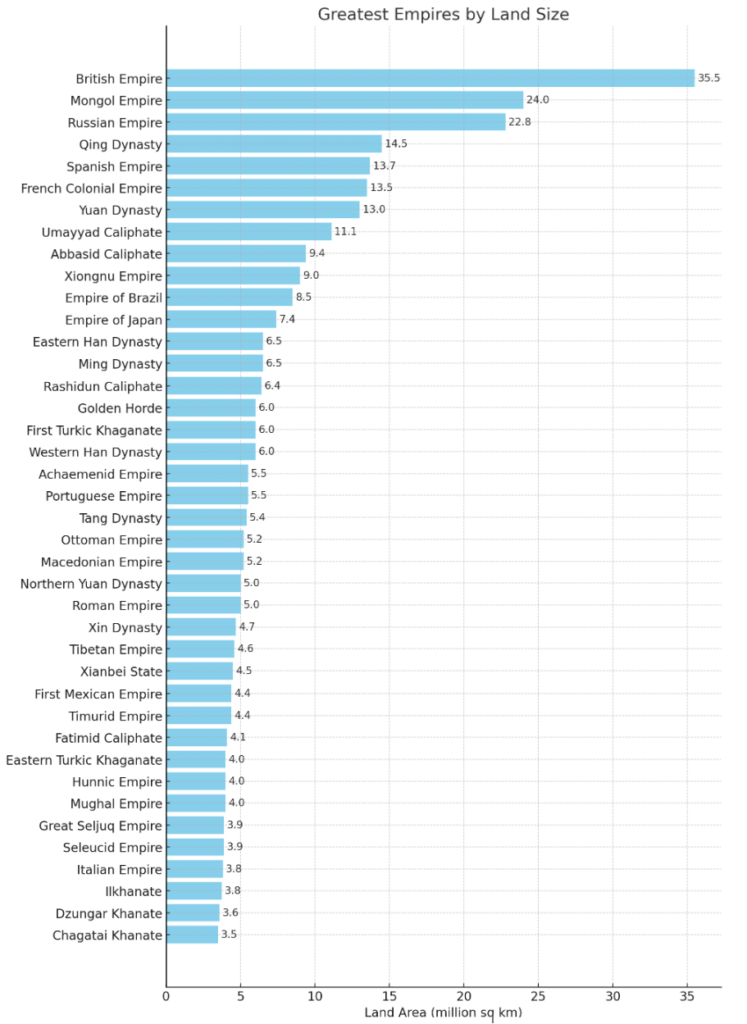
1. The British Empire
Peak Land Area: ~35.5 million square kilometers (1920)
The British Empire holds the title of the largest empire in history by land area. At its zenith, it controlled nearly a quarter of the Earth’s land surface, spanning continents including Europe, Asia, Africa, the Americas, and Oceania. The phrase “the sun never sets on the British Empire” encapsulated its global reach. Key territories included India, Canada, Australia, and parts of Africa, making it a dominant global power for centuries.

2. The Mongol Empire
Peak Land Area: ~24 million square kilometers (1270–1309)
Under the leadership of Genghis Khan and his successors, the Mongol Empire became the largest contiguous land empire in history. Stretching from Eastern Europe to the Sea of Japan, it covered vast swathes of Central Asia, the Middle East, and China. The empire is renowned for its military prowess, trade networks like the Silk Road, and its unification of diverse cultures under one administration.
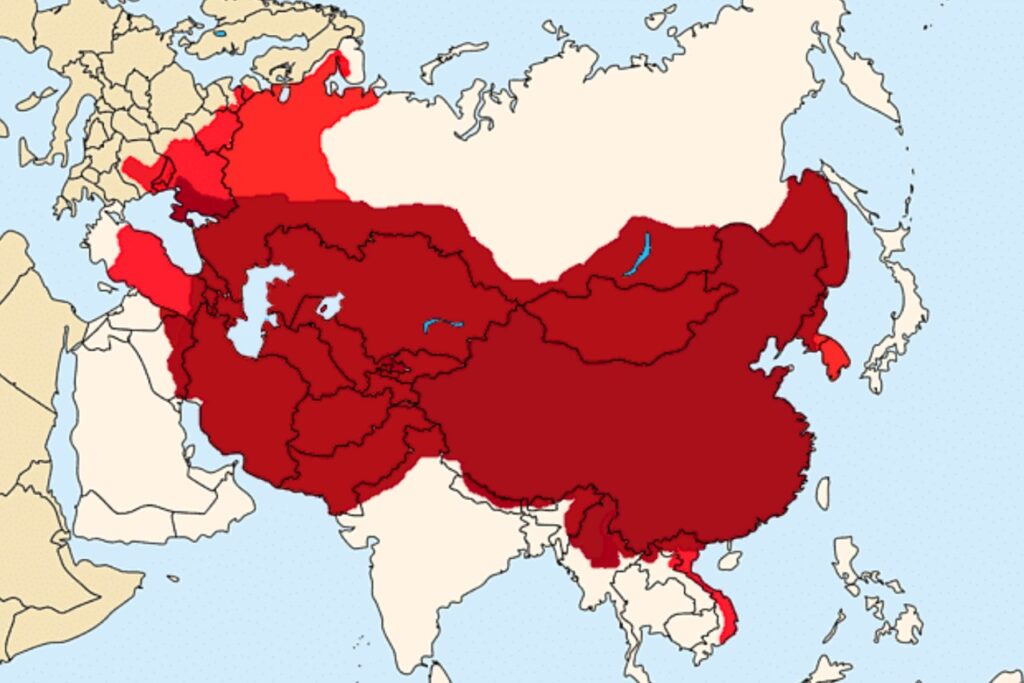
3. The Russian Empire
Peak Land Area: ~22.8 million square kilometers (1895)
The Russian Empire grew from its origins around Moscow to become one of the largest empires in history. At its peak, it stretched across three continents: Europe, Asia, and North America (via Alaska). The empire’s vast territories included Siberia, Central Asia, and parts of Eastern Europe. It played a significant role in global politics until its collapse in 1917 during the Russian Revolution.
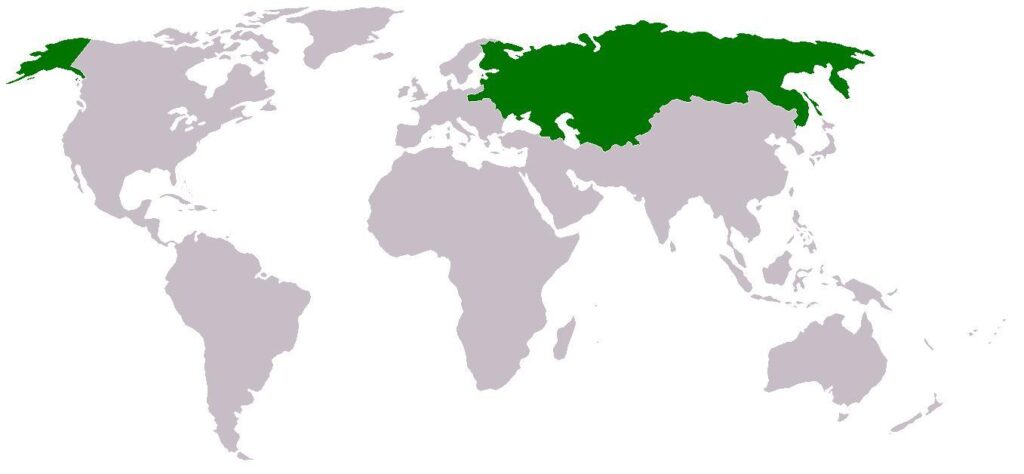
4. The Qing Dynasty (China)
Peak Land Area: ~14.5 million square kilometers (1790)
The Qing Dynasty was China’s last imperial dynasty and one of its largest. At its height, it controlled all of modern China, Taiwan, Mongolia, Tibet, and parts of Central Asia. The Qing rulers implemented centralized governance and expanded China’s borders to their greatest extent, overseeing significant cultural and technological developments.
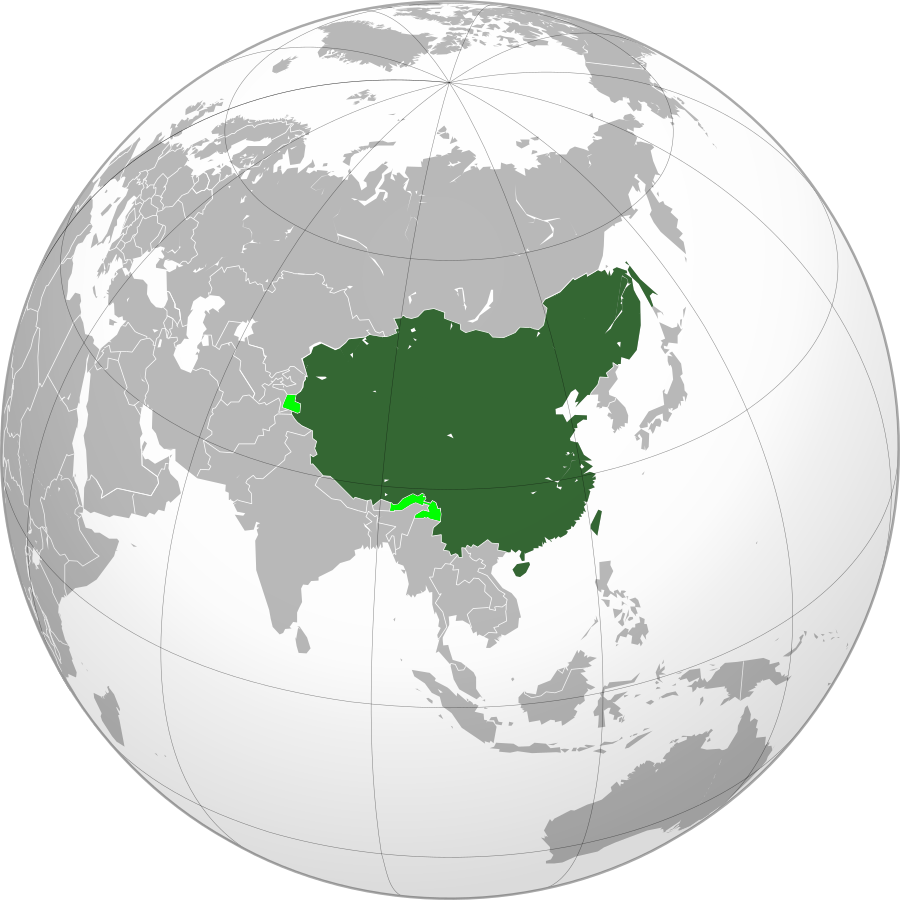
5. The Spanish Empire
Peak Land Area: ~13.7 million square kilometers (1810)
The Spanish Empire was one of the first global empires, with territories spanning Europe, the Americas, Africa, and Asia. It was a dominant maritime power, controlling vast parts of South America, Central America, and the Philippines. The empire’s wealth was largely derived from its colonies, particularly through the extraction of gold and silver.
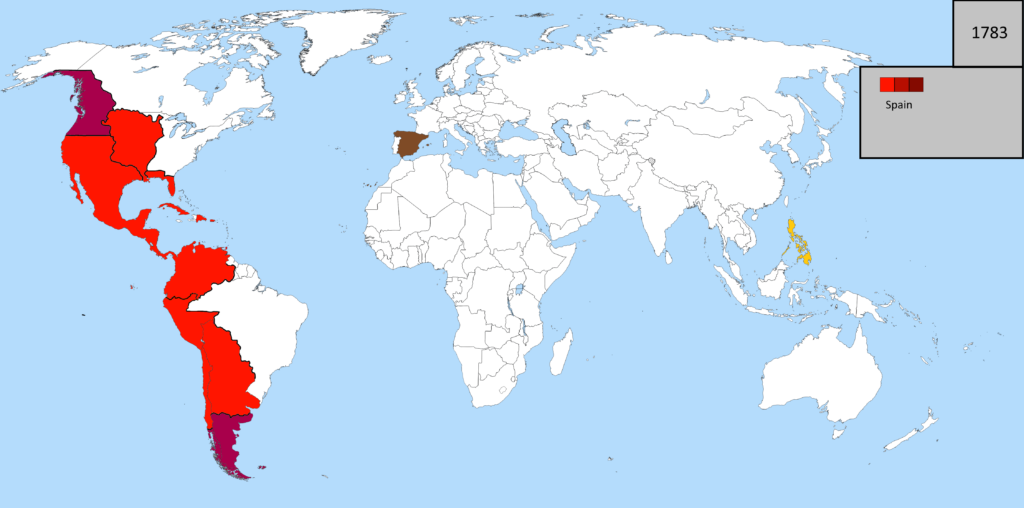
6. The French Colonial Empire
Peak Land Area: ~13.5 million square kilometers (1930s)
The French Empire consisted of territories in Africa, Southeast Asia, the Caribbean, and the Americas. It was one of the major colonial powers during the 19th and 20th centuries, spreading French culture, language, and influence across the globe.
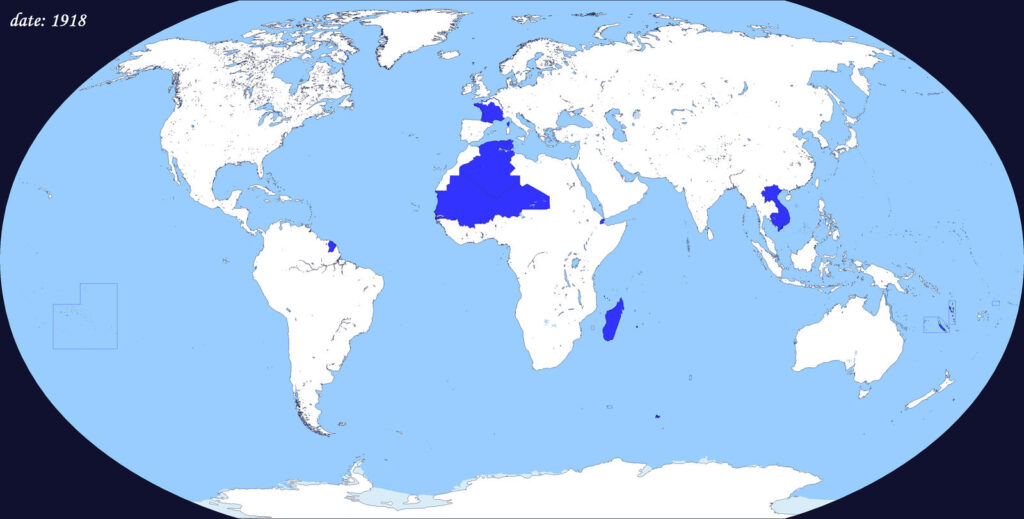
7. The Yuan Dynasty (China)
Peak Land Area: ~13 million square kilometers (1310)
Founded by Kublai Khan, a grandson of Genghis Khan, the Yuan Dynasty ruled over much of modern-day China and Mongolia. It was part of the greater Mongol Empire but functioned as a distinct dynasty that integrated Chinese and Mongol traditions, significantly influencing the region’s cultural and political landscape.
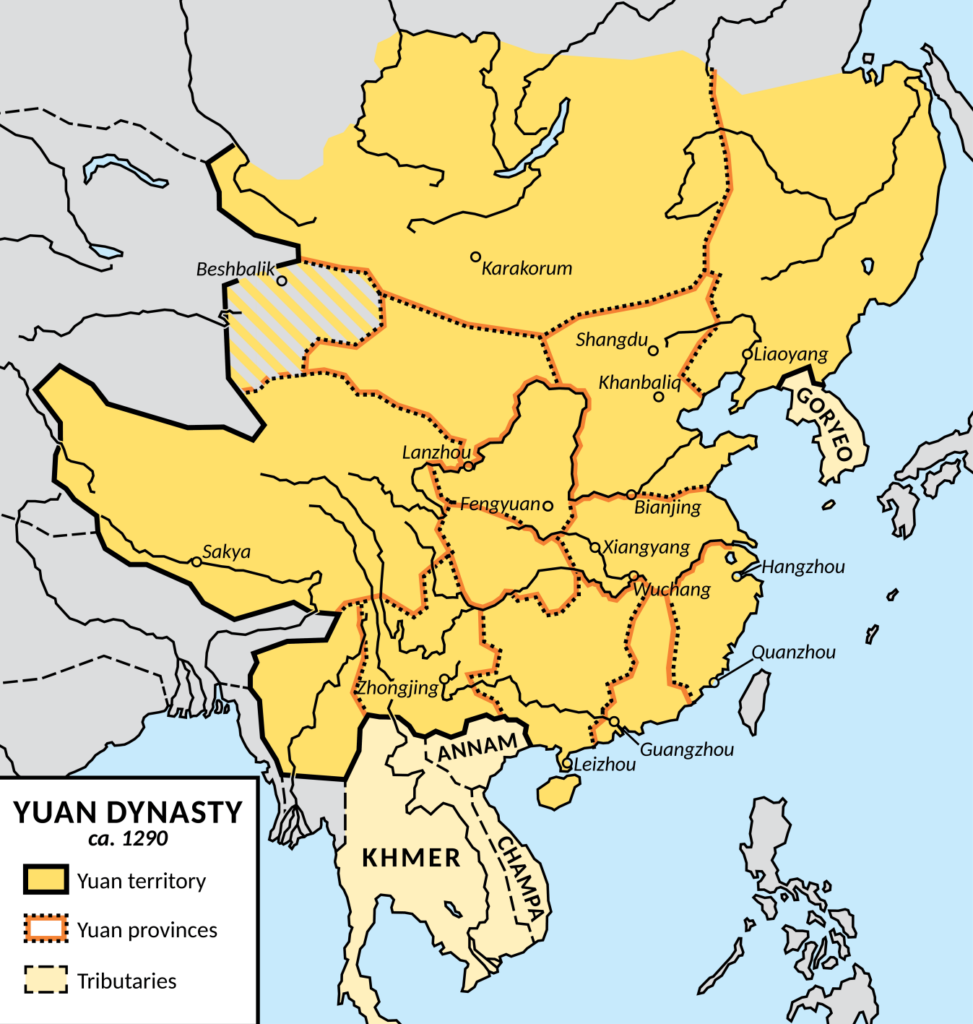
8. The Umayyad Caliphate
Peak Land Area: ~11.1 million square kilometers (750)
The Umayyad Caliphate was one of the largest Islamic empires, stretching from Spain in the west to India in the east. Known for its rapid expansion, the caliphate fostered the spread of Islam and significant cultural, scientific, and architectural achievements. Its legacy includes the establishment of Arabic as a unifying language across its territories.
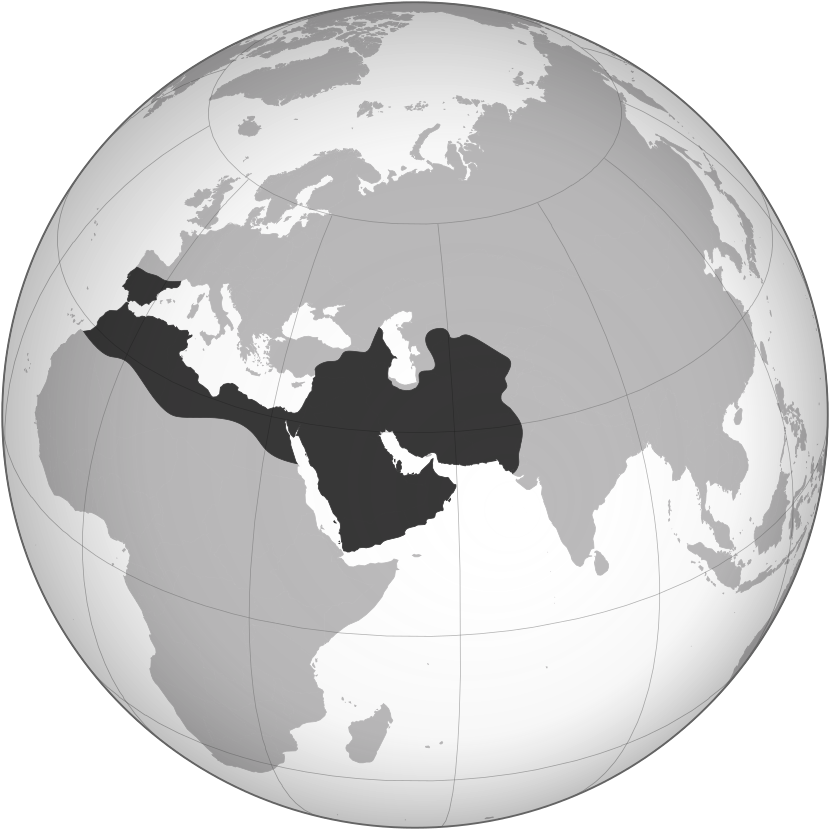
9. The Abbasid Caliphate
Peak Land Area: ~9.4 million square kilometers (850)
The Abbasid Caliphate, centered in Baghdad, succeeded the Umayyads and is remembered for its cultural and scientific golden age. Its influence extended from North Africa to Central Asia, playing a pivotal role in the preservation and dissemination of classical knowledge during the medieval period.
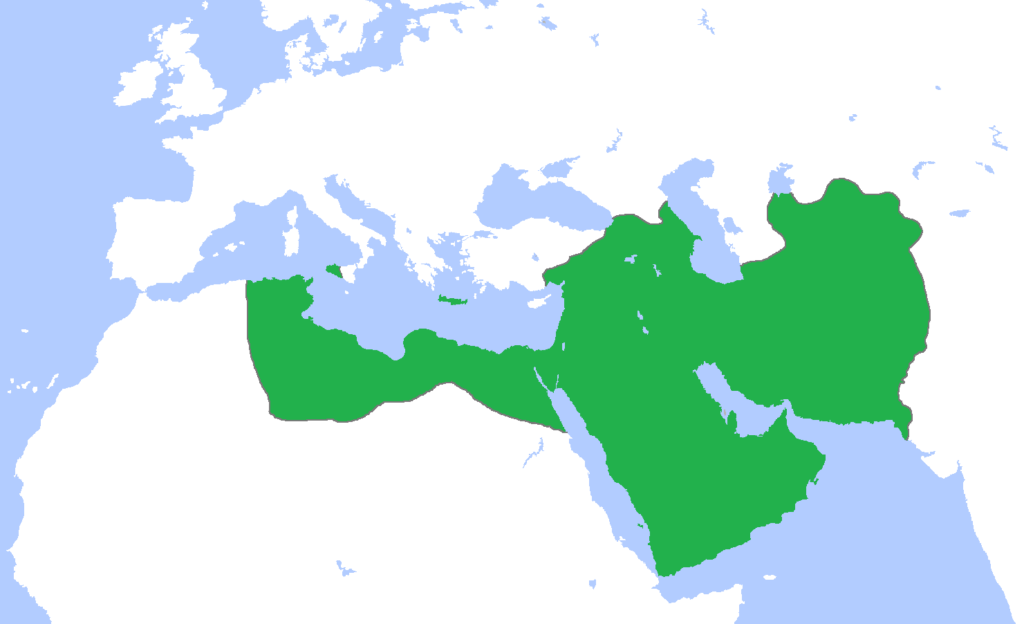
10. The Xiongnu Empire
Peak Land Area: ~9 million square kilometers (2nd Century BCE)
The Xiongnu Empire was a confederation of nomadic tribes that dominated the steppes of Central Asia during the Han Dynasty in China. Known for their exceptional cavalry and military strategies, they controlled trade routes and frequently clashed with the Han Chinese. Their empire stretched from Manchuria to the Caspian Sea. The Xiongnu influenced the development of the Silk Road and served as a precursor to later nomadic empires like the Mongols.
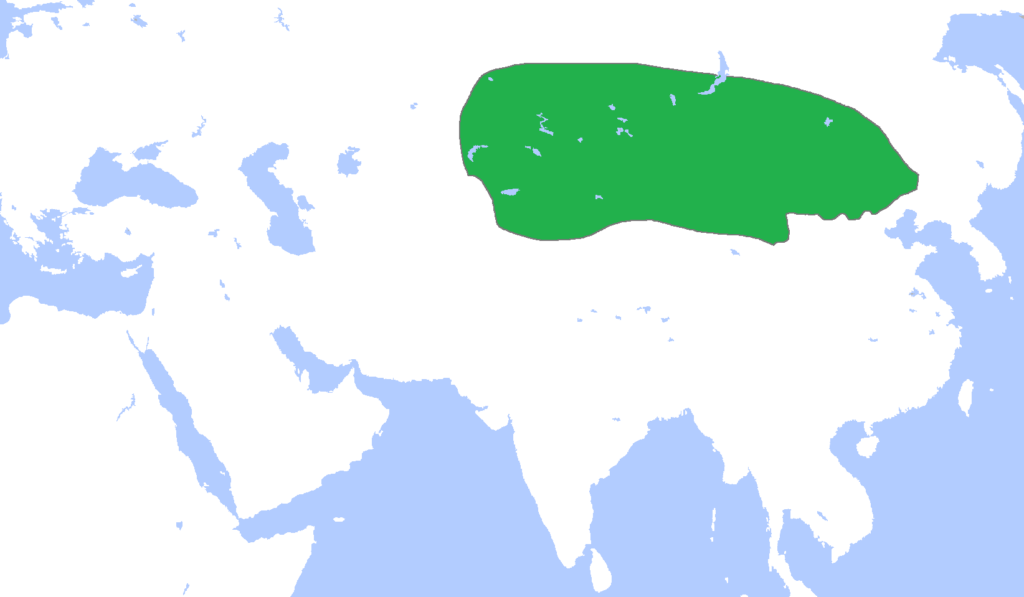
11. The Empire of Brazil
Peak Land Area: ~8.5 million square kilometers (1822–1889)
The Empire of Brazil emerged after its independence from Portugal in 1822, led by Emperor Dom Pedro I. Covering the vast territory of modern-day Brazil, it was one of the largest political entities in the Americas. The empire experienced political stability and economic growth compared to its neighbors, eventually transitioning into a republic in 1889 after Dom Pedro II’s reign.
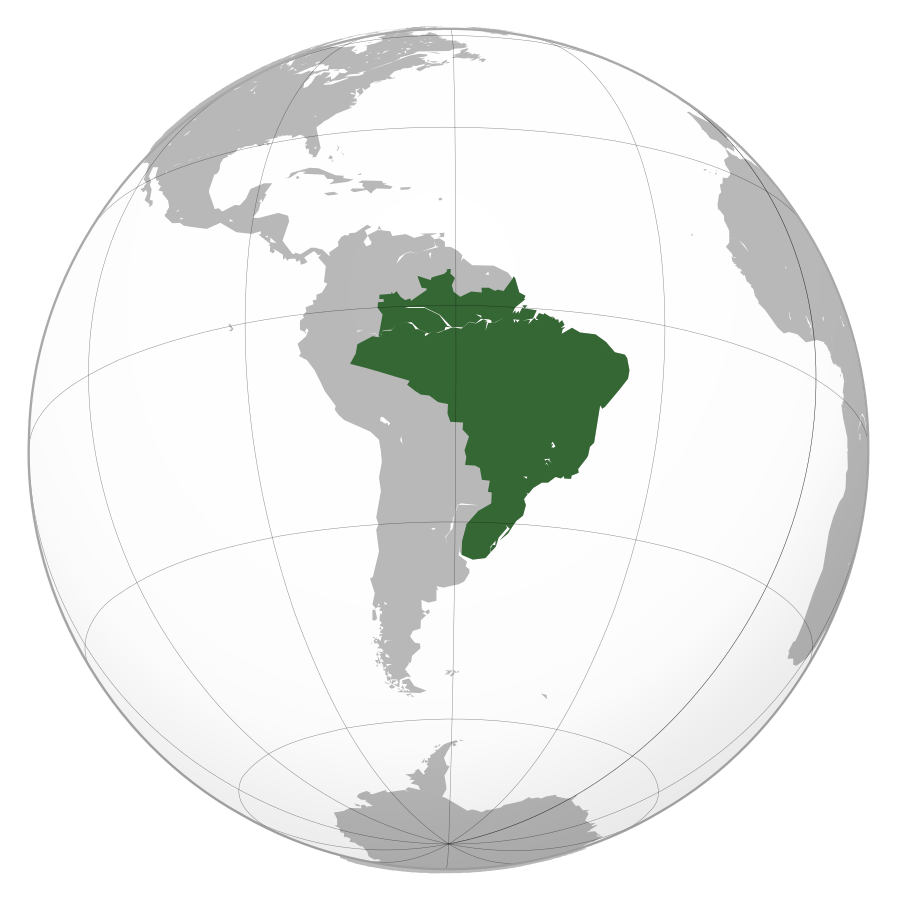
12. The Empire of Japan
Peak Land Area: ~7.4 million square kilometers (1942)
At its height during World War II, the Empire of Japan controlled much of East Asia and the Pacific, including Korea, Taiwan, parts of China, Southeast Asia, and numerous Pacific islands. Fueled by imperial ambitions, Japan’s expansion resulted in significant cultural and political influence in the region. The empire’s collapse in 1945 marked the end of Japanese imperialism, transitioning into the modern state of Japan.

13. The Eastern Han Dynasty
Peak Land Area: ~6.5 million square kilometers (2nd Century CE)
The Eastern Han Dynasty (25–220 CE) was the latter half of the Han Dynasty in China. It controlled vast territories, including present-day China, Korea, Vietnam, and parts of Central Asia. This period was marked by significant scientific and technological advancements, such as the invention of paper. However, internal corruption and peasant uprisings, such as the Yellow Turban Rebellion, led to the dynasty’s eventual fall.
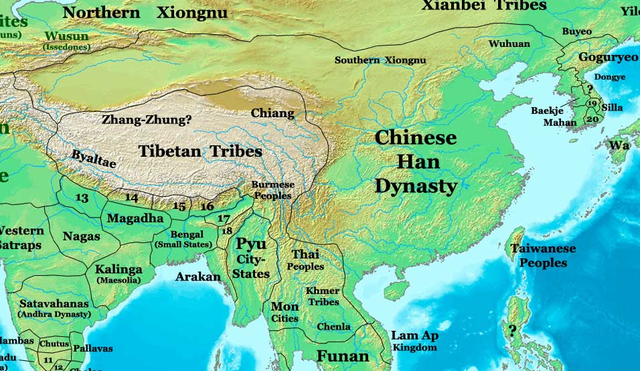
14. The Ming Dynasty
Peak Land Area: ~6.5 million square kilometers (15th Century)
The Ming Dynasty (1368–1644) was a period of Chinese resurgence following the fall of the Mongol-led Yuan Dynasty. The Ming restored native Han Chinese rule and expanded its territories significantly. Known for its cultural and economic prosperity, the Ming is remembered for its iconic architecture, such as the Forbidden City, and maritime expeditions led by Zheng He. The dynasty fell to the Manchu-led Qing Dynasty in the 17th century.
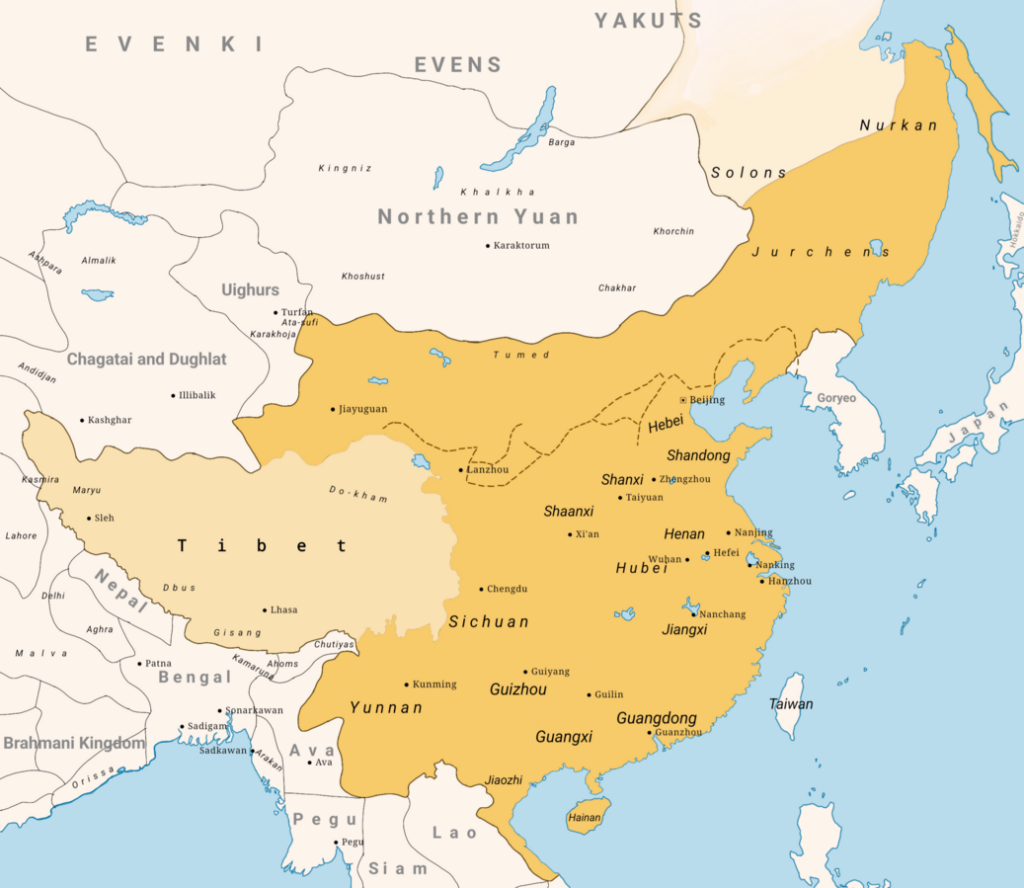
15. The Rashidun Caliphate
Peak Land Area: ~6.4 million square kilometers (654)
The Rashidun Caliphate (632–661) was the first Islamic caliphate established after the death of Prophet Muhammad. It rapidly expanded through the Middle East, North Africa, and parts of Persia under the leadership of the four “Rightly Guided” Caliphs. Known for its governance and administration, the caliphate laid the foundation for Islamic civilization and the spread of Islam beyond Arabia.
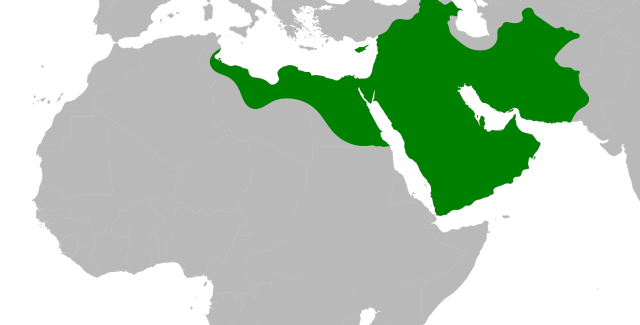
16. The Golden Horde
Peak Land Area: ~6 million square kilometers (13th–14th Centuries)
The Golden Horde was a division of the Mongol Empire, founded by Batu Khan, a grandson of Genghis Khan. It controlled a vast region spanning Eastern Europe and parts of Central Asia, with its capital in Sarai along the Volga River. Known for its influence on Russian principalities, the Golden Horde played a significant role in shaping Eastern European history until its fragmentation in the 15th century.
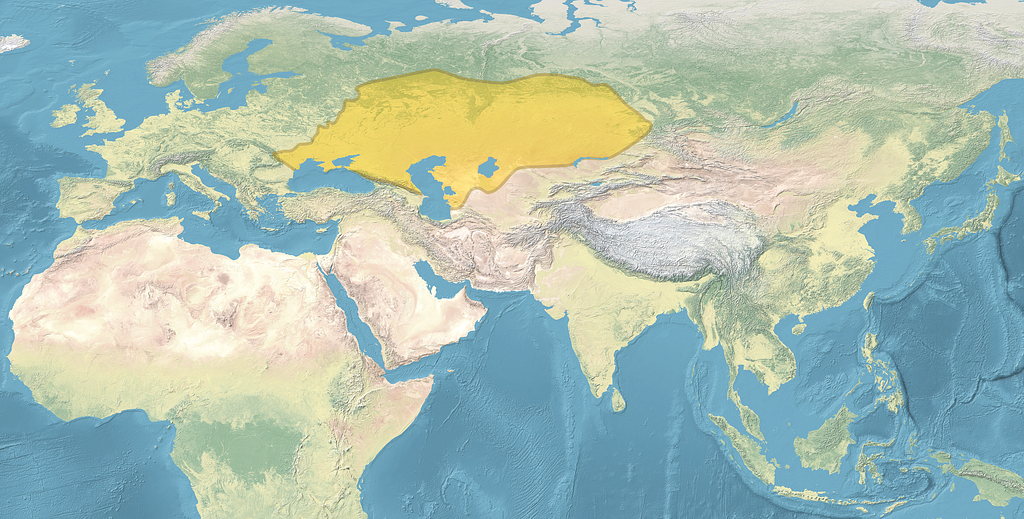
17. The First Turkic Khaganate
Peak Land Area: ~6 million square kilometers (6th Century CE)
The First Turkic Khaganate (552–603) was an early Turkic empire that emerged in Central Asia. It united various Turkic tribes under one rule, stretching from the Altai Mountains to the Black Sea. Known for their nomadic lifestyle and military prowess, the Turks controlled key trade routes, including parts of the Silk Road. Internal divisions eventually led to the khaganate’s split into eastern and western factions.
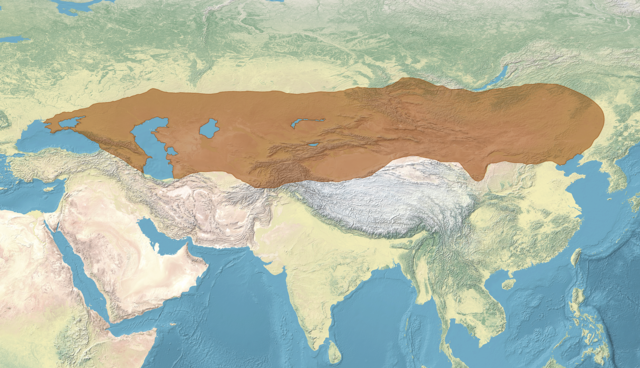
18. The Western Han Dynasty
Peak Land Area: ~6 million square kilometers (50 BCE)
The Western Han Dynasty (206 BCE–9 CE) was the first and larger phase of the Han Dynasty. It marked a period of territorial expansion and consolidation in China, extending its borders into Korea, Vietnam, and Central Asia. This era saw the establishment of the Silk Road, facilitating trade and cultural exchange between East and West. The Western Han is renowned for advancements in governance, Confucian philosophy, and scientific achievements.

19. The Achaemenid Empire
Peak Land Area: ~5.5 million square kilometers (500 BCE)
The Achaemenid Empire, founded by Cyrus the Great, was the first Persian Empire and one of the largest in ancient history. Spanning from the Balkans to the Indus Valley, it united a diverse array of cultures under a centralized administration. The empire is celebrated for its innovations, including an extensive road network and an early postal system. Its fall came at the hands of Alexander the Great, who admired its governance and preserved some of its structures.
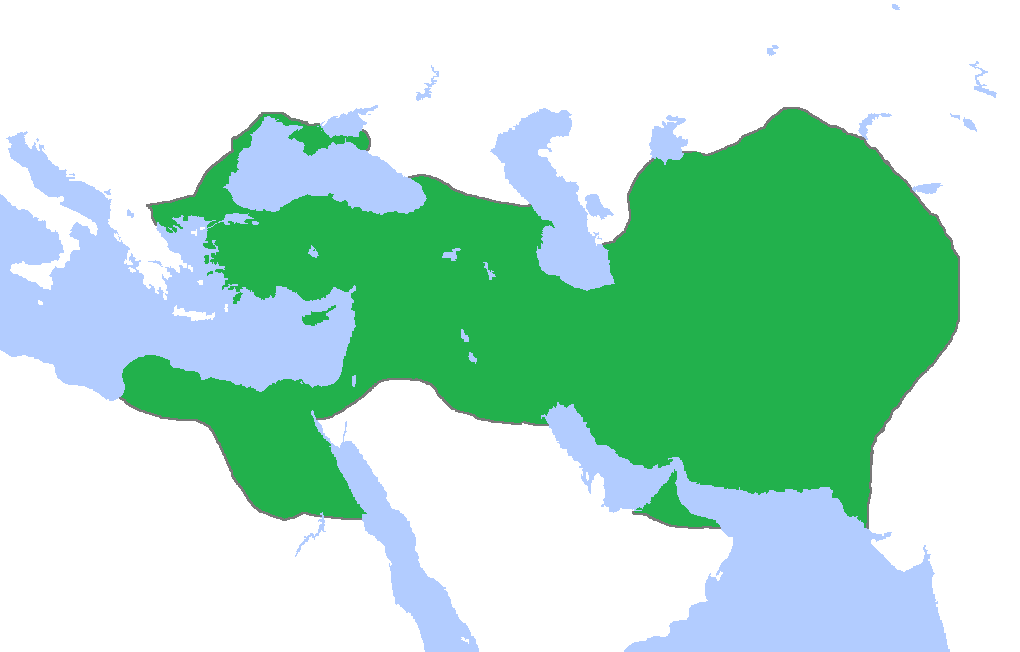
20. The Portuguese Empire
Peak Land Area: ~5.5 million square kilometers (1820)
The Second Portuguese Empire reached its height during the early 19th century, with territories in South America (modern Brazil), Africa, and Asia. Portugal’s influence extended across key maritime routes, enabling a lucrative trade in spices, gold, and other commodities. Despite its decline in the 19th and 20th centuries, the empire’s legacy is evident in the Portuguese-speaking world, which spans continents today.
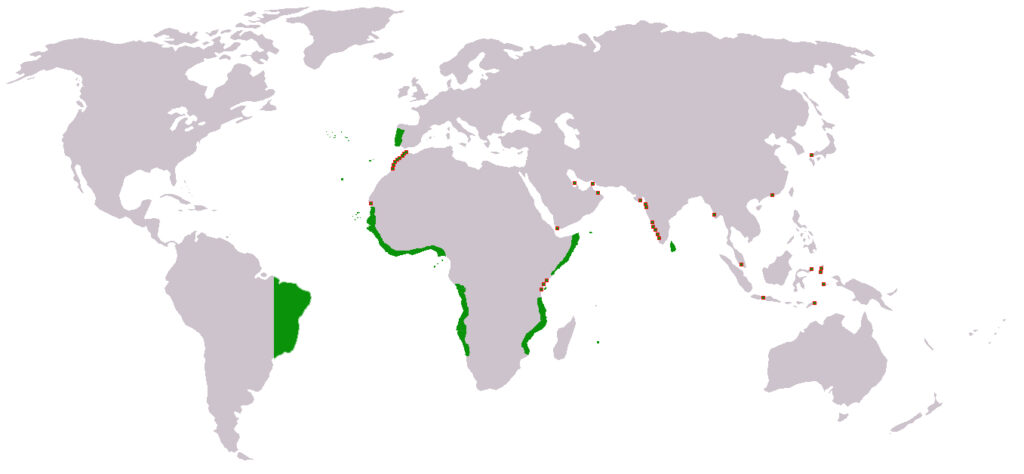
21. The Tang Dynasty
Peak Land Area: ~5.4 million square kilometers (715 CE)
The Tang Dynasty (618–907 CE) presided over one of China’s most culturally and economically prosperous periods. Stretching across Central Asia and into parts of Southeast Asia, the Tang controlled the Silk Road, facilitating trade and cultural exchange. Renowned for its art, poetry, and innovation, the dynasty’s capital, Chang’an (modern-day Xi’an), was one of the largest and most cosmopolitan cities in the world at the time.

22. The Ottoman Empire
Peak Land Area: ~5.2 million square kilometers (1683)
The Ottoman Empire, centered in modern-day Turkey, controlled territories across Southeast Europe, the Middle East, and North Africa. Known for its longevity, the empire was a significant cultural and economic bridge between East and West for over six centuries.
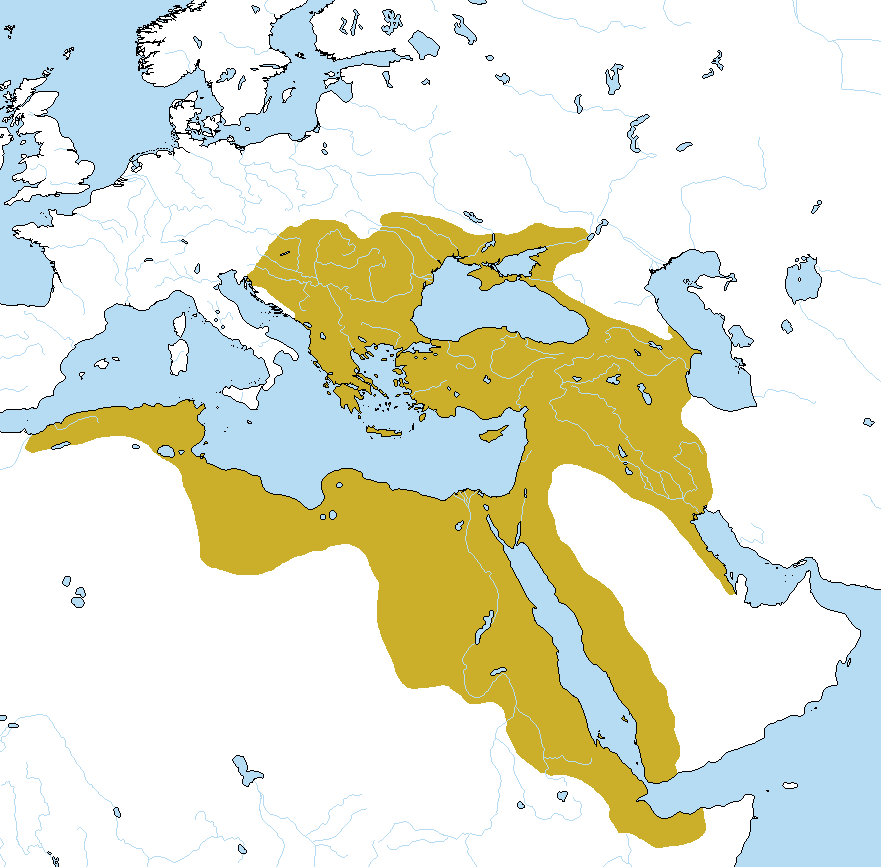
23. The Macedonian Empire
Peak Land Area: ~5.2 million square kilometers (323 BCE)
The Macedonian Empire, founded by Alexander the Great, was one of the largest empires of the ancient world. It stretched from Greece to Egypt and as far as India. Alexander’s conquests spread Hellenistic culture, blending Greek traditions with those of Persia, Egypt, and India. The empire fragmented into smaller Hellenistic kingdoms after his death but left a profound legacy on art, science, and governance.
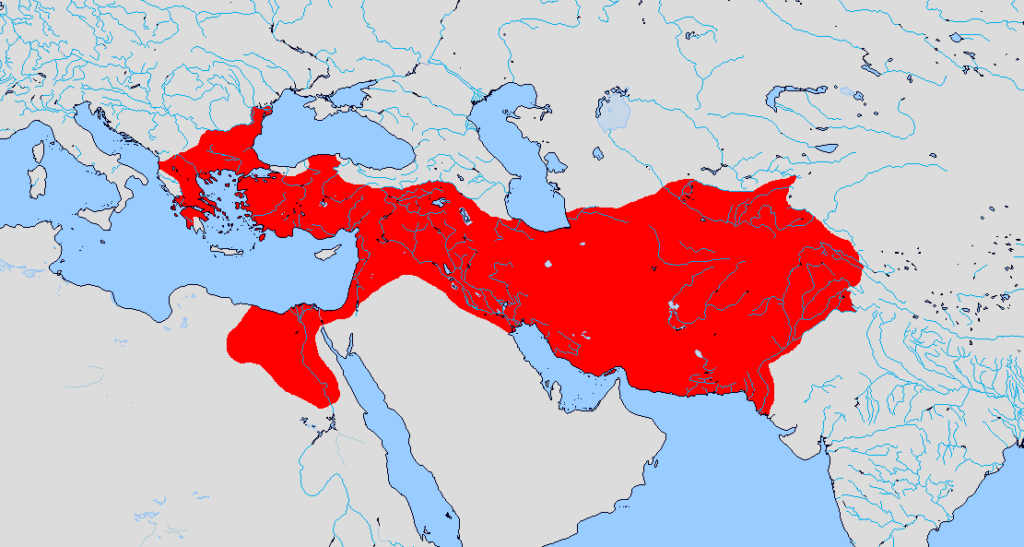
24. The Northern Yuan Dynasty
Peak Land Area: ~5 million square kilometers (1368 CE)
The Northern Yuan Dynasty emerged after the fall of the Mongol-led Yuan Dynasty in China. It was based in Mongolia and represented the remnants of the once-dominant Mongol Empire. Although its influence waned over time, the Northern Yuan retained control over a significant expanse of Inner Asia. It played a vital role in the history of the Mongols and their interactions with Ming China.
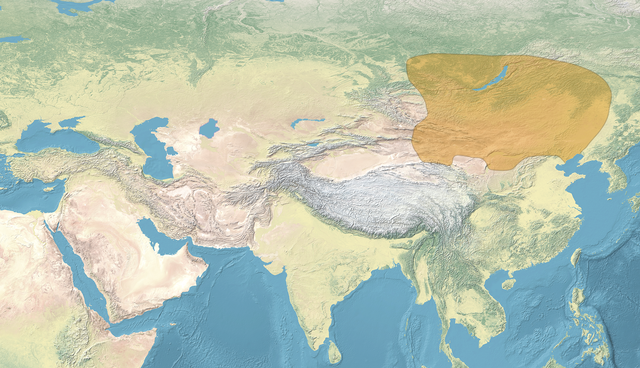
25. The Roman Empire
Peak Land Area: ~5 million square kilometers (117 CE)
At its peak under Emperor Trajan, the Roman Empire spanned three continents: Europe, Asia, and Africa. Renowned for its advanced engineering, legal systems, and military might, the Roman Empire influenced governance, language, and architecture for centuries. The empire’s vast road network and Pax Romana fostered trade and cultural exchange, shaping the foundations of Western civilization.
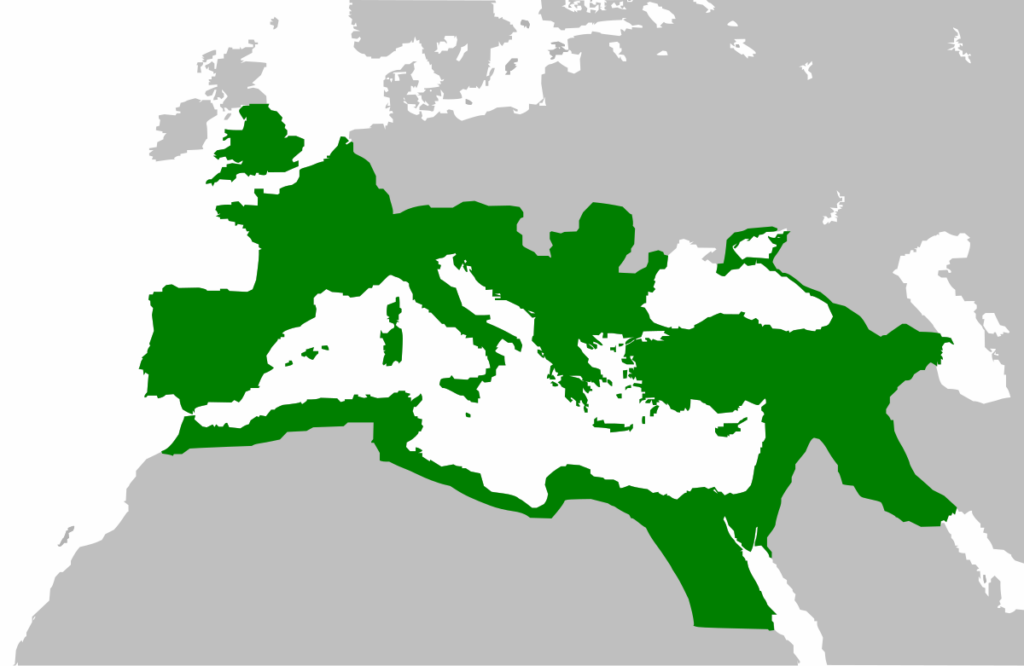
26. The Xin Dynasty
Peak Land Area: ~4.7 million square kilometers (10 CE)
The Xin Dynasty (9–23 CE), founded by Wang Mang, was a short-lived dynasty that interrupted the Han Dynasty. Wang Mang implemented radical reforms, including land redistribution, but faced significant opposition, leading to instability. Despite its brief existence, the Xin Dynasty controlled vast territories and significantly impacted Chinese history during its transitionary period.
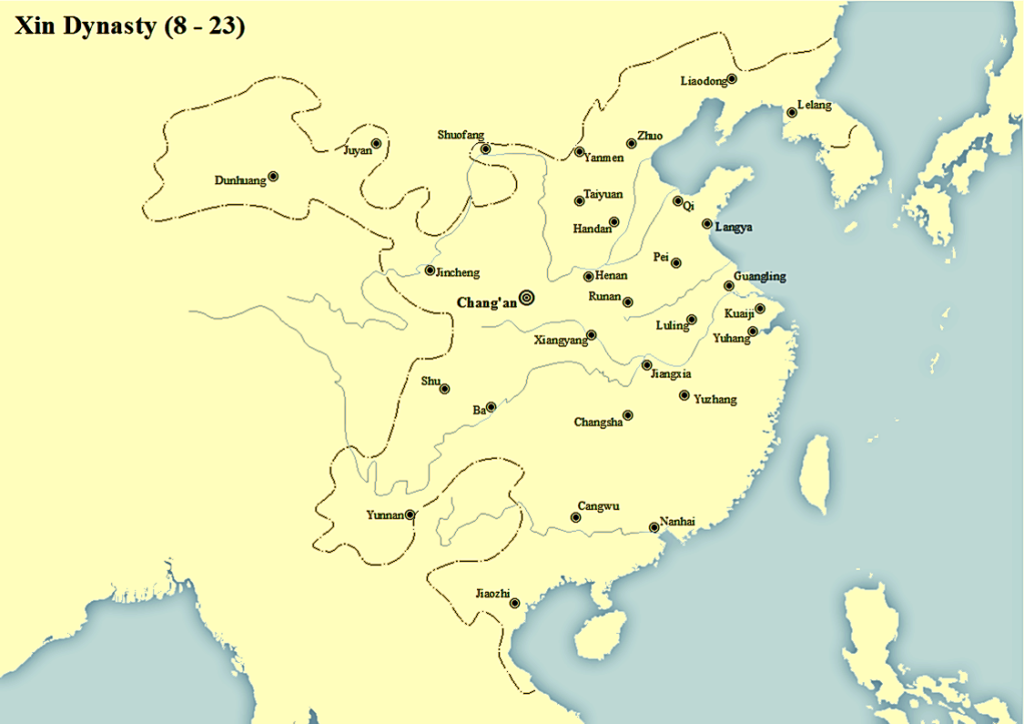
27. The Tibetan Empire
Peak Land Area: ~4.6 million square kilometers (800 CE)
The Tibetan Empire (7th–9th centuries CE) reached its height under Emperor Trisong Detsen. Spanning the Tibetan Plateau, Central Asia, and parts of China and India, it played a key role in regional politics. Known for its promotion of Buddhism and interactions with the Tang Dynasty, the Tibetan Empire significantly influenced the cultural and religious development of the region.
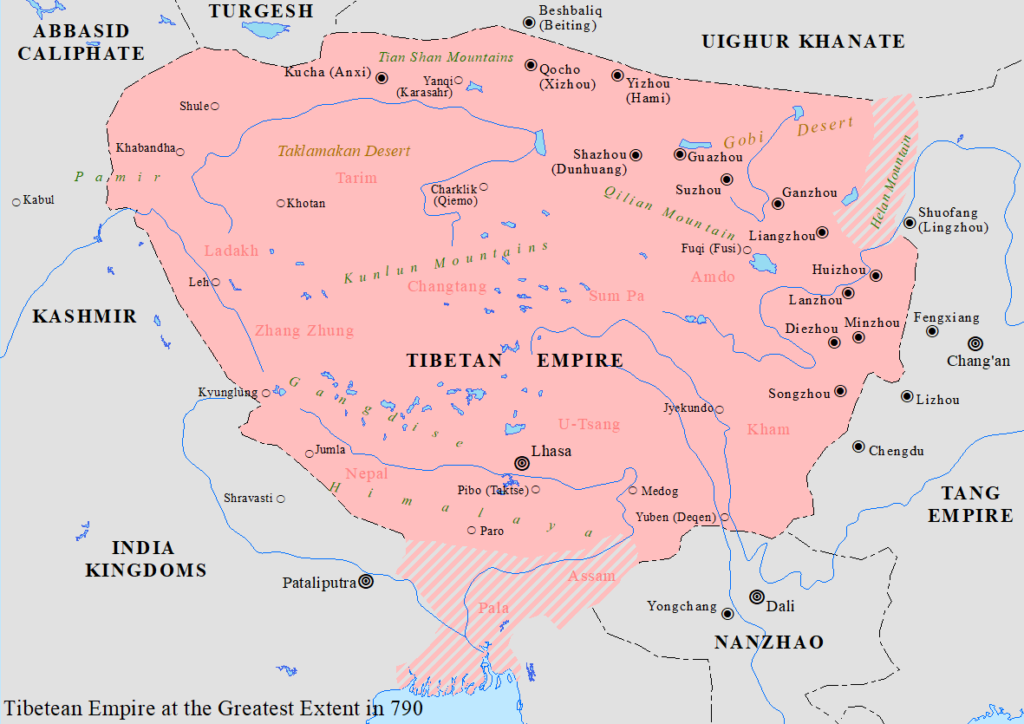
28. The Xianbei State
Peak Land Area: ~4.5 million square kilometers (200 CE)
The Xianbei State was a confederation of nomadic tribes that rose to prominence after the fall of the Xiongnu. Centered in the steppes of modern Mongolia and northern China, the Xianbei played a critical role in shaping early Chinese frontier history. They were instrumental in cultural exchanges between the nomadic and settled civilizations, paving the way for later states like the Northern Wei.
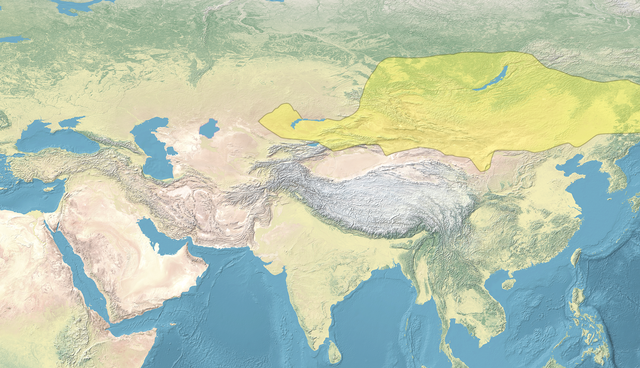
29. The First Mexican Empire
Peak Land Area: ~4.4 million square kilometers (1821 CE)
The First Mexican Empire was established after Mexico’s independence from Spain in 1821. Covering present-day Mexico and parts of Central America, it was one of the largest political entities in the Americas. Under Emperor Agustín de Iturbide, the empire faced significant challenges due to internal divisions and external pressures, leading to its dissolution into a republic in 1823.
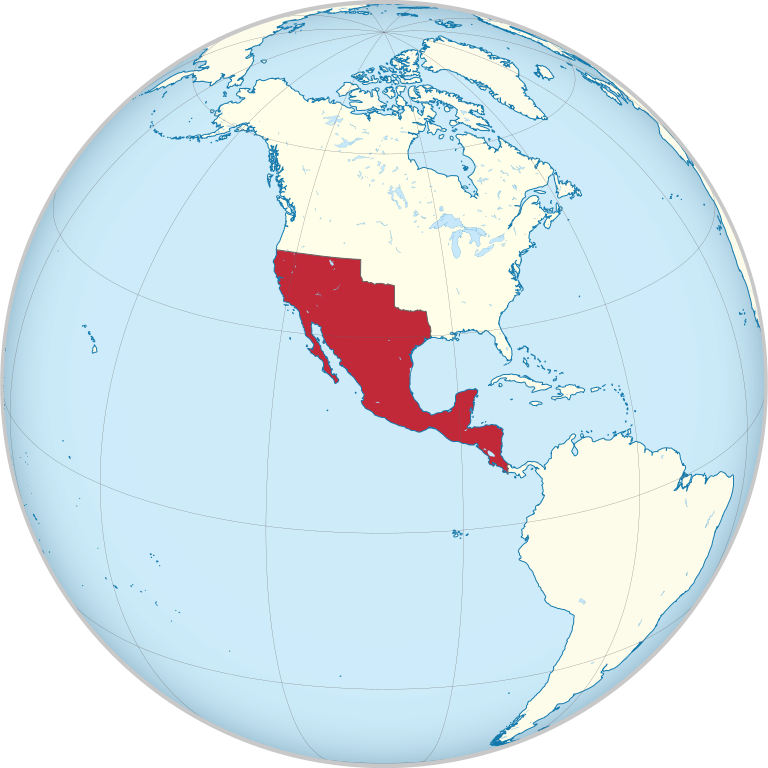
30. The Timurid Empire
Peak Land Area: ~4.4 million square kilometers (1405 CE)
The Timurid Empire, founded by Timur (Tamerlane), was a Central Asian empire that extended from the Levant to India. Renowned for its architectural and cultural achievements, including the city of Samarkand, the empire blended Persian, Turkic, and Mongol influences. While short-lived, the Timurids left a significant legacy, influencing the development of the later Mughal Empire in India.
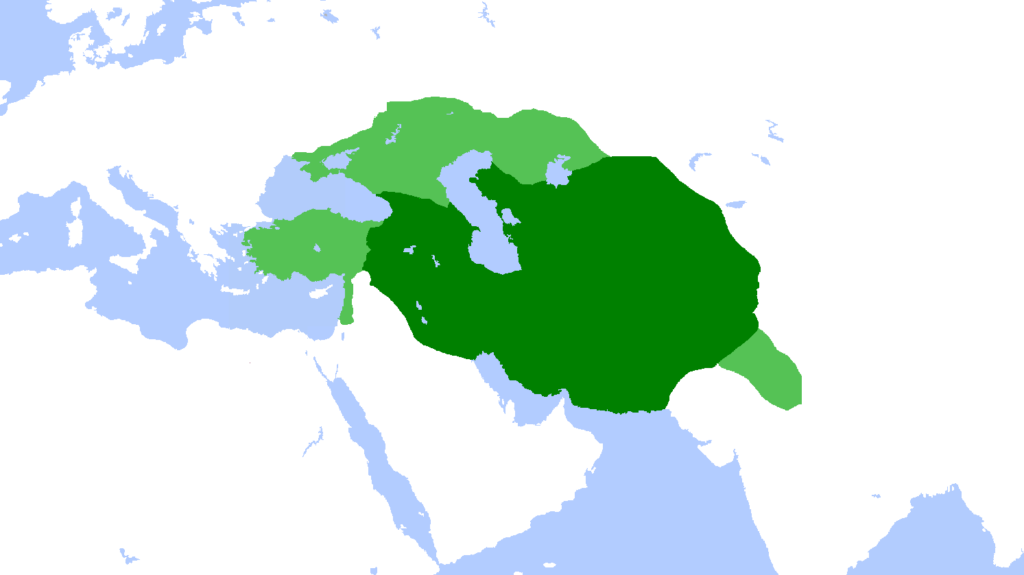
31. The Fatimid Caliphate
Peak Land Area: ~4.1 million square kilometers (969 CE)
The Fatimid Caliphate was an Islamic empire that originated in North Africa and extended across Egypt, the Levant, and parts of Arabia. The Fatimids, followers of Shia Islam, established Cairo as their capital, which became a major cultural and economic hub. The caliphate is remembered for its architectural marvels, including Al-Azhar Mosque, and for fostering intellectual advancements during its reign.
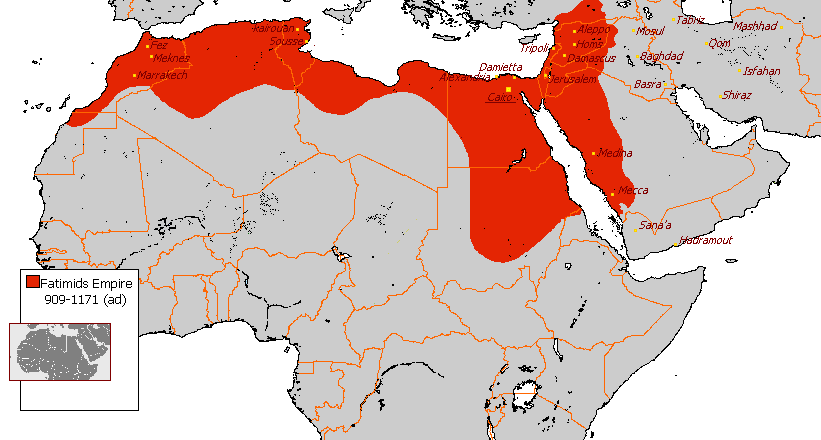
32. The Eastern Turkic Khaganate
Peak Land Area: ~4 million square kilometers (624 CE)
The Eastern Turkic Khaganate was a successor state to the First Turkic Khaganate. It controlled vast territories in Central Asia, spanning the Mongolian steppes and parts of modern China. This nomadic empire played a key role in maintaining the steppe trade routes and influencing the political landscape of East and Central Asia before being absorbed by the Tang Dynasty.
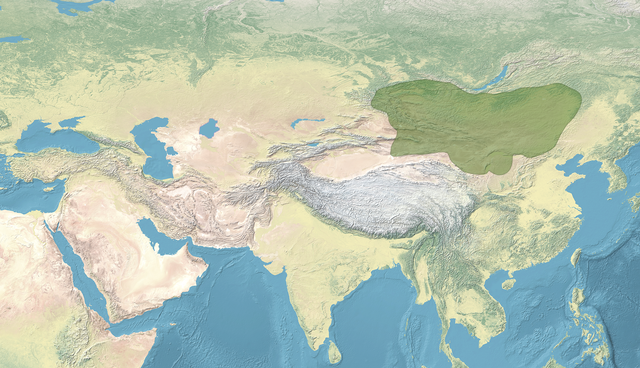
33. The Hunnic Empire
Peak Land Area: ~4 million square kilometers (441 CE)
The Hunnic Empire, led by the famous Attila the Hun, was a confederation of nomadic tribes that dominated parts of Europe and Central Asia during the 4th and 5th centuries. Known for their military tactics and ability to instill fear in both the Roman and Byzantine Empires, the Huns played a pivotal role in the decline of the Western Roman Empire.

34. The Mughal Empire
Peak Land Area: ~4 million square kilometers (1690 CE)
The Mughal Empire ruled much of the Indian subcontinent, blending Persian, Indian, and Central Asian influences. Under emperors like Akbar, Shah Jahan, and Aurangzeb, it achieved remarkable cultural and economic prosperity. Renowned for its architectural achievements, including the Taj Mahal, the Mughal Empire profoundly influenced Indian society and governance, leaving a lasting legacy.

35. The Great Seljuq Empire
Peak Land Area: ~3.9 million square kilometers (1080 CE)
The Great Seljuq Empire was a medieval Sunni Muslim empire that controlled much of Persia, Anatolia, and Central Asia. It played a key role in the spread of Islam and served as a bridge between the Islamic world and the Turkic steppe. Known for its patronage of art and science, the Seljuqs fostered cultural and intellectual flourishing during their reign.

36. The Seleucid Empire
Peak Land Area: ~3.9 million square kilometers (301 BCE)
The Seleucid Empire was one of the major Hellenistic states that emerged after the death of Alexander the Great. Spanning from the Aegean Sea to the Indus River, the empire served as a bridge between Greek and Persian cultures. Renowned for its urban development and trade along the Silk Road, the Seleucids played a critical role in the spread of Hellenistic culture across Asia.

37. The Italian Empire
Peak Land Area: ~3.825 million square kilometers (1941 CE)
The Italian Empire reached its peak during World War II under Benito Mussolini’s rule. It included territories in North Africa, the Horn of Africa, the Dodecanese Islands, and parts of the Balkans. While short-lived, the empire sought to recreate the glory of ancient Rome. Its expansion efforts faced significant resistance and ended with Italy’s defeat in the war.

38. The Ilkhanate
Peak Land Area: ~3.75 million square kilometers (1310 CE)
The Ilkhanate was a division of the Mongol Empire that controlled Persia, the Caucasus, and parts of the Middle East. Founded by Hulagu Khan, a grandson of Genghis Khan, the Ilkhanate played a pivotal role in the cultural and economic exchanges between East and West. Its rulers adopted Islam, blending Mongol and Persian traditions, and their patronage led to advancements in art and science.
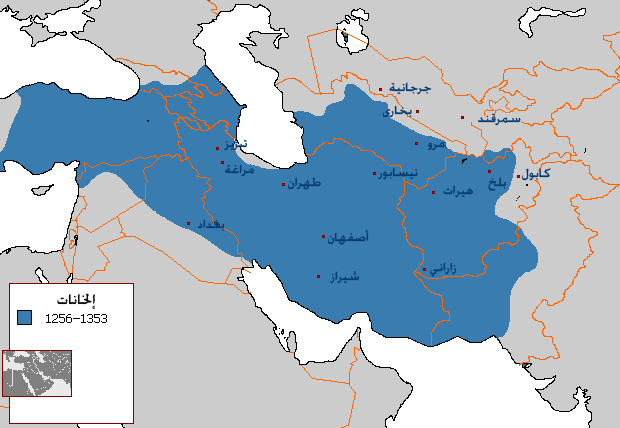
39. The Dzungar Khanate
Peak Land Area: ~3.6 million square kilometers (1650 CE)
The Dzungar Khanate, centered in the western region of modern-day China, was one of the last great nomadic empires. Ruled by the Oirat Mongols, it controlled parts of Central Asia, including Xinjiang and neighboring regions. Known for their resistance to the Qing Dynasty, the Dzungars maintained a strong political and military presence until their defeat and dissolution in the late 18th century.
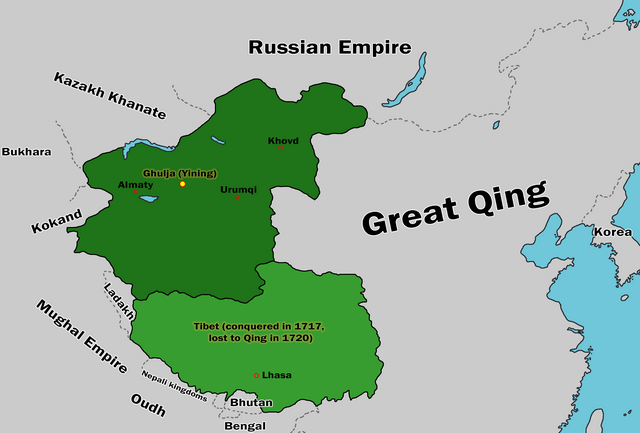
40. The Chagatai Khanate
Peak Land Area: ~3.5 million square kilometers (1310 or 1350 CE)
The Chagatai Khanate, named after Chagatai Khan, the second son of Genghis Khan, was a successor state of the Mongol Empire. It controlled Central Asia, spanning from the Amu Darya River to the Altai Mountains. The khanate played a significant role in facilitating trade along the Silk Road and acted as a cultural crossroads, blending Turkic, Mongol, and Islamic influences. Although it eventually fractured into smaller states, its legacy persisted in the political and cultural history of Central Asia.
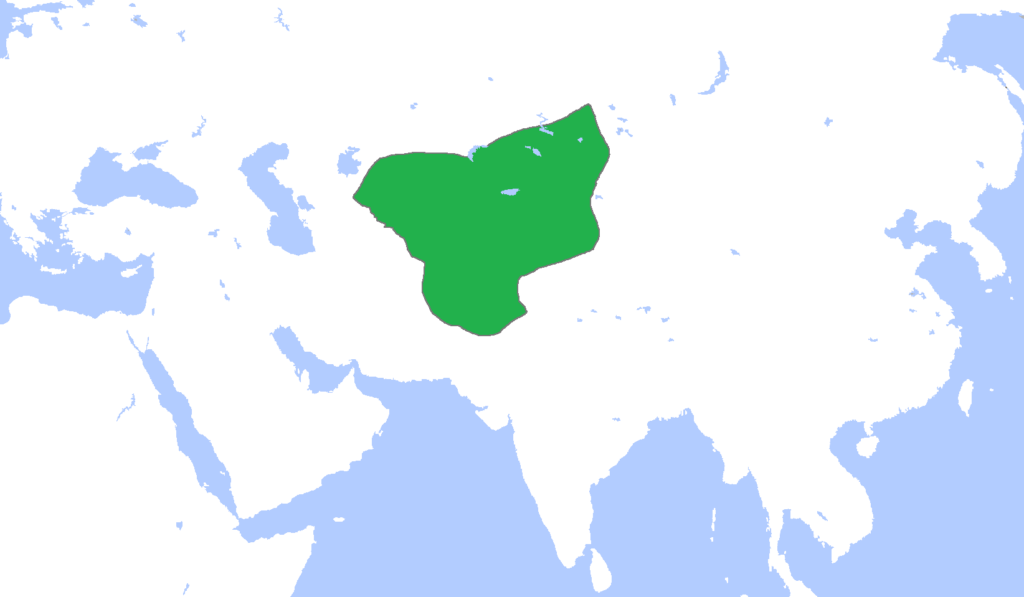
Attributions:
“Featured Image” by Sharklord1 is licensed under the Creative Commons Attribution-NoDerivatives 3.0 License, available via DeviantArt.
The British Empire: User:Andrew0921, CC BY-SA 3.0 https://creativecommons.org/licenses/by-sa/3.0, via Wikimedia Commons
The Mongol Empire: Bin thúi ờm, CC BY-SA 4.0 https://creativecommons.org/licenses/by-sa/4.0, via Wikimedia Commons
The Russian Empire: Diegom809, Creative Commons Attribution-ShareAlike 3.0 License
The Qing Dynasty (China): Aldermanseven, CC BY-SA 4.0 https://creativecommons.org/licenses/by-sa/4.0, via Wikimedia Commons
The Spanish Empire: SirEctoTzy(Jamesjames1024), CC BY-SA 4.0 https://creativecommons.org/licenses/by-sa/4.0, via Wikimedia Commons
The French Colonial Empire: HistoryRedone, Creative Commons Attribution-NonCommercial-No Derivatives Works 3.0 License, via deviantart.com
The Yuan Dynasty (China): Cattette, CC BY 4.0 https://creativecommons.org/licenses/by/4.0, via Wikimedia Commons
The Umayyad Caliphate: Ali Zifan, CC BY-SA 4.0 https://creativecommons.org/licenses/by-sa/4.0, via Wikimedia Commons
The Abbasid Caliphate: Original image by Gabagool. Uploaded by Syed Muhammad Khan, 2020, Creative Commons Attribution
The Xiongnu Empire: Gabagool, CC BY 3.0 https://creativecommons.org/licenses/by/3.0, via Wikimedia Commons
The Empire of Brazil: File:First Brazilian Empire (orthographic projection).svg: Heraldryderivative work: Jon C, CC BY-SA 3.0 http://creativecommons.org/licenses/by-sa/3.0/, via Wikimedia Commons
The Empire of Japan: Original: historicair Vector: TastyCakes, CC BY-SA 3.0 https://creativecommons.org/licenses/by-sa/3.0, via Wikimedia Commons
The Eastern Han Dynasty: East-Hem_200ad.jpg: Thomas Lessman (Contact!)derivative work: Hongkongresident, CC BY-SA 3.0 https://creativecommons.org/licenses/by-sa/3.0, via Wikimedia Commons
The Ming Dynasty: Fazoffic, Creative Commons Attribution-Share Alike 4.0 International (Deed – Attribution-ShareAlike 4.0 International – Creative Commons), via Wikimedia Commons
The Rashidun Caliphate: NuclearVacuum, CC BY-SA 4.0 https://creativecommons.org/licenses/by-sa/4.0, via Wikimedia Commons
The Golden Horde: Public Domain Dedication (CC0) via picryl.com
The First Turkic Khaganate: KtrinkoUser:Greenvert, CC BY-SA 4.0 https://creativecommons.org/licenses/by-sa/4.0, via Wikimedia Commons
The Western Han Dynasty: User:Historian of the arab people, Public domain, via Wikimedia Commons
The Achaemenid Empire: Gabagool, CC BY 1.0 https://creativecommons.org/licenses/by/1.0, via Wikimedia Commons
The Portuguese Empire: Creative Commons Attribution-Share Alike 3.0 Unported, via Wikimedia Commons
The Tang Dynasty: Ian Kiu, CC BY-SA 3.0 http://creativecommons.org/licenses/by-sa/3.0/, via Wikimedia Commons
The Ottoman Empire: Sharklord1, Creative Commons Attribution-NoDerivatives 3.0 License, available via DeviantArt.
The Macedonian Empire: Sharklord1, Creative Commons Attribution-NoDerivatives 3.0 License, available via DeviantArt.
The Northern Yuan Dynasty: naturalearthdata.com, offered to the Public Domain per Terms of Use, CC BY-SA 4.0 https://creativecommons.org/licenses/by-sa/4.0, via Wikimedia Commons
The Roman Empire: Angelus, CC BY-SA 3.0 http://creativecommons.org/licenses/by-sa/3.0/, via Wikimedia Commons
The Xin Dynasty: SS, CC BY-SA 4.0 https://creativecommons.org/licenses/by-sa/4.0, via Wikimedia Commons
The Tibetan Empire: SY, CC BY-SA 4.0 https://creativecommons.org/licenses/by-sa/4.0, via Wikimedia Commons
The Xianbei State: naturalearthdata.com, offered to the Public Domain per Terms of Use, CC BY-SA 4.0 https://creativecommons.org/licenses/by-sa/4.0, via Wikimedia Commons
The First Mexican Empire: Milenioscuro, CC BY-SA 4.0 https://creativecommons.org/licenses/by-sa/4.0, via Wikimedia Commons
The Timurid Empire: Timur073767, CC BY-SA 4.0 https://creativecommons.org/licenses/by-sa/4.0, via Wikimedia Commons
The Fatimid Caliphate: Arab League at English Wikipedia, CC BY-SA 3.0 http://creativecommons.org/licenses/by-sa/3.0/, via Wikimedia Commons
The Eastern Turkic Khaganate: naturalearthdata.com, offered to the Public Domain per Terms of Use, CC0, via Wikimedia Commons
The Hunnic Empire: public domain, via picryl.com
The Mughal Empire: Gabagool, CC BY 3.0 https://creativecommons.org/licenses/by/3.0, via Wikimedia Commons
The Great Seljuq Empire: Gabagool, CC BY 3.0 https://creativecommons.org/licenses/by/3.0, via Wikimedia Commons
The Seleucid Empire: Ali Zifan, CC BY-SA 4.0 https://creativecommons.org/licenses/by-sa/4.0, via Wikimedia Commons
The Italian Empire: Theirrulez, CC BY-SA 3.0 https://creativecommons.org/licenses/by-sa/3.0, via Wikimedia Commons
The Ilkhanate: Ilkhanate in 1256–1353.PNG : Richee Richee Richee Oi Oi Oiderivative work: Freedom’s Falcon, CC BY-SA 3.0 http://creativecommons.org/licenses/by-sa/3.0/, via Wikimedia Commons
The Dzungar Khanate: Wario2, CC BY-SA 4.0 https://creativecommons.org/licenses/by-sa/4.0, via Wikimedia Commons
The Chagatai Khanate: Gabagool, CC BY 3.0 https://creativecommons.org/licenses/by/3.0, via Wikimedia Commons

